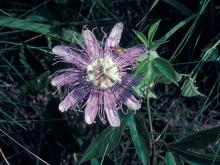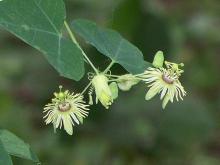Wildflowers, Grasses and Other Nonwoody Plants
Media

Species Types
Scientific Name
Securigera varia (formerly Coronilla varia)
Description
In summer, you’re almost guaranteed to see big colonies of crown vetch along Missouri's highways. This weedy nonnative plant stabilizes the dirt after road construction but degrades our natural ecosystems.
Media

Species Types
Scientific Name
Ludwigia peploides
Description
Water primrose is a common shoreline plant with bright yellow flowers and long, trailing stems. It grows in dense mats in the shallow areas of ponds, lakes, and streams.
Media

Species Types
Scientific Name
Pueraria montana
Description
Of the many invasive nonnative plants that were originally introduced to stop soil erosion and improve soils, kudzu is one of the worst. This “vine that ate the South” is often the first plant that comes to mind when we think of “invasive plants.”
Media

Species Types
Scientific Name
Dioscorea oppositifolia (sometimes called D. batatas)
Description
Similar to kudzu, Chinese yam is an aggressive vine that overtakes nearly everything within reach that stands still long enough! Learn more about this invasive plant — and please don’t plant it!
Media

Species Types
Scientific Name
Commelina communis
Description
The flowers of dayflower are truly blue, and they have only two conspicuous petals. A fast-growing, sprawling, but shallow-rooted weed, this introduced species commonly annoys gardeners.
Media

Species Types
Scientific Name
Passiflora incarnata
Description
The bizarre, complicated flowers attract attention! The fruits are edible. Passion flower is a nonwoody vine that climbs via tendrils on trees or other structures. It is native to the southeastern United States, including southern Missouri.
Media

Species Types
Scientific Name
Passiflora lutea
Description
Yellow passion flower is the smaller of Missouri’s two Passiflora species. Both are vines that climb via tendrils. This one has yellowish-green flowers about an inch wide. Look for it along and south of the Missouri River.
Media

Species Types
Scientific Name
Fallopia japonica
Description
One of the worst invasive species in the world, Japanese knotweed can thrive in many places and can even damage foundations of buildings — not to mention the harm it causes in natural habitats. Learn to recognize it so you can prevent its spread.
Media

Species Types
Scientific Name
Fallopia scandens (formerly Polygonum scandens)
Description
Climbing false buckwheat is a rampant, native, annual or perennial climber that often forms curtainlike masses of twining red stems, covering shrubs and trees. Look for it in moist, open or shaded bottomlands, alluvial valleys, and floodplains.
Media

Species Types
Scientific Name
Ipomoea pandurata
Description
Wild potato vine is related to the sweet potatoes we buy at grocery stores. This native vine is also related to the morning glories that decorate trellises and to the bindweed that plagues gardeners and farmers.
See Also
About Wildflowers, Grasses and Other Nonwoody Plants in Missouri
A very simple way of thinking about the green world is to divide the vascular plants into two groups: woody and nonwoody (or herbaceous). But this is an artificial division; many plant families include some species that are woody and some that are not. The diversity of nonwoody vascular plants is staggering! Think of all the ferns, grasses, sedges, lilies, peas, sunflowers, nightshades, milkweeds, mustards, mints, and mallows — weeds and wildflowers — and many more!





















